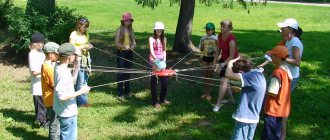Meaning and types of games
Children's games for the entire period of Soviet education were not collected, not generalized, that is, not classified. The famous psychologist A. N. Leontiev rightly Fr.
The most common theories of the game in the 19th and 20th centuries:
K. Gross believed that play is the unconscious preparation of a young organism for life.
K. Schiller, G. Spencer explained the game as a simple waste of excess energy that the child accumulates. It is not used for work and is therefore expressed in play activities.
K. Bühler emphasized the usual enthusiasm with which children play, arguing that the whole point of play lies in the pleasure it gives the child.
Z. Freud believed that a child is encouraged to play by his own feeling of inferiority.
Although these explanations of play seem different, all these authors argue that the basis of play is the instinctive, biological needs of the child: his drives and desires.
Russian and Soviet scientists have a fundamentally different approach to explaining the game:
A. I. Sikorsky, P. F. Kapterev, P. F. Lesgat, K. D. Ushinsky prove the uniqueness of the game as a truly human activity.
N. Krupskaya, A.S. Makarenko, and then many teachers and psychologists deepened the analysis of the game and strictly scientifically explained this peculiar children's activity.
Children's games are characterized by the following features:
- play is a form of active reflection by a child of the human life around him.
- The peculiarity of the game is precisely the method that the child uses in this activity.
- the game, like any other human activity, is social by nature, so it changes with changes in the historical conditions of people's lives
- play is a form of creative reflection of reality by a child.
- play is an operation of cognition, a means of clarification and enrichment, a way of exercising and, consequently, developing the cognitive and moral abilities and strengths of the child.
6) In its developed form, play is a collective activity.
7.Diverse development of children, the game itself also changes and develops.
There are different types of games: Movement, didactics, drama, constructive games.
In early childhood, elements of role-playing play appear and begin to form. In role-playing games, children satisfy their desire to live with adults and, in a special, playful form, reproduce the relationships and work activities of adults.
A. N. Leontyev, D. B. Elkonin, A. V. Zaporozhets called role-playing the leading activity of a preschool child. Role-playing play arises and exists in combination with other types of children's exercises: first of all, with observations of the surrounding life, listening to stories and conversations with adults.
D. B. Elkonin, based on an analysis of ethnographic research, came to the conclusion that role-playing game arose during the historical development of society, as a result of a change in the child’s place in the system of social relations, that is, it is social in origin. The emergence of play is not associated with the action of some innate, instinctive forces, but with certain conditions of the child’s life in society. Childhood dragged on, and with the advent of role-playing games, a new stage in the mental development of the child arose - preschool age. D.B. Elkonin emphasized that the extension of childhood occurs not by superimposing a new period on an existing one, but by wedging it in a way.
The game is social not only in its origin, but also in its content. All researchers who describe role-playing note that it has a great influence on the child’s surrounding reality; the actions of children’s games are determined by the social, everyday, and family conditions of the child’s life.
The role of play in the mental development of a child
Play is the leading activity in preschool age and has a significant impact on the development of the child.
In play activities, the child’s mental qualities and personal characteristics are most intensively formed. Other types of activities are formed in the game, which then acquire independent value.
Play affects all aspects of mental development, which is constantly emphasized by both teachers and psychologists. For example, Makarenko wrote: “Game is important in a child’s life, it has the same value as an adult’s activity, work, service. What a child is like in the game is how he will work in many ways when he grows up. Therefore, the training of the future actor occurs primarily in the game. And the entire history of man as a worker or employee can be represented in the development of play and its gradual transition into work.
Gaming activity influences the formation of the volitional nature of mental processes. Thus, in the game the child begins to develop voluntary attention and voluntary memory. In a playful environment, children concentrate better and remember better. A conscious goal is given to the child earlier and easier in the game. The conditions of the game themselves require the child to concentrate attention on the objects contained in the game situation, on the content of the actions being played out and the plot. If a child does not want to pay attention to what is required of him in the upcoming game situation, if he does not remember the conditions of the game, his peers will simply drive him away.
The game situation of action in it has a constant impact on the development of the mental activity of a preschool child. In the game, the child learns to act with a substitute object - he gives the substitute object a new game name and acts with it in accordance with this name. Gradually, play actions with objects are reduced, the child learns to think about objects and mentally act with them. Thus, play makes a significant contribution to the child's gradual transition to thinking in terms of ideas.
At the same time, the experience of play and, above all, the child’s real relationships in role-playing play lays the foundations for a special quality of thinking, allows the child to put himself in the point of view of others, anticipate their future behavior and base his own behavior on it.
Role-playing games have a certain value for the development of imagination.
The influence of the game on the development of the child’s personality lies in the fact that through it he learns about the behavior and relationships of adults, who become models for his own behavior, and in it he acquires basic communication skills, qualities necessary for contact with peers. By capturing the child and forcing him to follow the rules contained in the assumed role, play contributes to the development of feelings and voluntary regulation of behavior.
At different stages of preschool childhood, the child’s productive activities - drawing, design - are closely related to play. Interest in drawing and design initially arises as a playful interest aimed at the process of forming a drawing or design in accordance with the game plan. Only in middle and older preschool age does interest shift to the result of the activity, and it is freed from the influence of the game.
Within the framework of gaming activities, educational activities begin to form, which subsequently become the leading activities. Learning is introduced by adults, it does not occur directly during the game. But a preschooler begins to learn through play—he calls learning a kind of role-playing game with certain rules. However, by following these rules, the child quietly masters basic learning activities.
GAMES WITH RULES
Games with rules are a special group of games specially created by folk or scientific pedagogy to solve certain problems in teaching and raising children. These are games with ready-made content, with fixed rules that are an indispensable component of the game. Educational tasks are implemented through the child’s playful actions when performing some task (find, say the opposite, catch a ball, etc.).
Depending on the nature of the educational task, games with rules are divided into two large groups - didactic and outdoor games, which, in turn, are classified taking into account different bases. Thus, didactic games are divided according to content ( mathematical, natural history, speech , etc.), according to didactic material ( games with objects and toys, board-printed, verbal).
Outdoor games are classified according to the degree of mobility (games of small, medium, high mobility), by the predominant movements ( games with jumping, running, etc. ), by used in the game ( games with a ball, with ribbons, with hoops, etc. .).
Among didactic and outdoor games, there are plot games in which the players play roles (“Cat and Mouse”, “Souvenir Shop”), and plotless ones (“Magic Wand”, “What has changed?”, etc.).
In games with rules, the child is attracted by the gameplay, the desire to perform game actions, achieve results, and win. But this game process is mediated by some kind of task (not just rearrange the pictures, but place them in pairs, match them according to a certain feature; not just run, but run away from the fox). And this makes the child’s behavior arbitrary, subject to game conditions in the form of rules. As A.N. Leontiev rightly noted, mastering the rules of the game means mastering one’s behavior. It is the fact that in games with rules the child learns to control his behavior that determines their educational significance.
In terms of moral development , D. B. Elkonin especially highlighted those in games with rules that have a dual task. So, in the game of rounders, a child can, after catching the ball, return to the circle the player who was “greasy” earlier. This means that behavior in the game is guided by a double task: to run yourself, dodging the ball, and to catch the ball in order to help a friend who was hit by the ball. The child’s actions may be limited to only deft running, but he sets himself another goal - to help his friend, although this is associated with risk: if the attempt to catch the ball is unsuccessful, he will have to leave the circle of players. Thus, in games with a dual task, the child, on his own initiative, helps a friend and rejoices when he succeeds. In real life, such situations do not arise often, and children’s behavior is more often guided by the teacher’s verbal instructions: “Help Artem tie a scarf”; “Help Lisa remove the cubes.” It is difficult to cultivate comradely solidarity with such instructions. Another thing is games with rules that require mutual assistance from participants, especially if teams act and compete (“Whose team is most likely to build a house?”, relay race games).
Games with rules give each participant the opportunity to compare their actions and their results with the actions and results of others (Seryozha is very dexterous - it is difficult for a trap to catch him; Sasha often breaks the rules, argues when he is told about it, plays dishonestly; I catch the ball poorly and, Although I know a lot of plants, I lose in the game “Name the plant”). It is also valuable that the child tries to independently evaluate his Thus, games with rules are beneficial for the development of preschoolers’ ability to mutually evaluate and self-esteem. The fact that a child in a specific game situation that is interesting to him, brightly, emotionally colored, sees his mistakes, non-compliance with the requirements and realizes this in comparison, makes him want to become better, i.e. gives rise to a desire for self-improvement. Also, success in the game (he was dexterous, quick-witted, put together a mosaic pattern) raises him in his own eyes and the eyes of other children, encourages him to new efforts and achievements. Thus, games with rules are the most important means of raising and teaching preschool children.
Speech development
Play has a very great influence on the development of language. A gaming situation requires a certain level of development of verbal communication from each child participating in it. The need to communicate with peers stimulates the development of coherent speech. In the game, children learn to fully communicate with each other. Younger preschoolers do not yet know how to truly communicate with their peers.
In children of middle and senior preschool age, despite their inherent egocentrism, children agree with each other, both before the role-playing game and in the game itself.
If for some serious reason the joint game breaks down, then the communication process also breaks down.
Play, like other types of activity, requires preschoolers to demonstrate certain moral and volitional qualities and establish contacts with peers.
In order for the game to be successful, the child must have the skills that A.P. Usova called the qualities of “sociability.” She described these skills as the ability to act together, to establish connections with other children, the ability to find one's place among children playing, to take initiative and convince others to accept the game, to be attentive to peers, the ability to influence children not only by organizing them, but also to obey certain requirements peers, take into account their opinions. These qualities are formed and manifested in the process of communication in the joint play of children.
In the game, disputes and conflicts may arise in the process of resolving communicative organizational issues. As noted by N.S. Pantina, children often quarrel not because playing activities lead to the fact that partners have many different ideas about the actions of one or another participant.
The nature of the conflict in the game indicates its development as a joint activity.
Play as a leading activity is of particular importance for the development of the sign function of children's language. Mastery of the sign function of language leads to a radical restructuring of all mental functions of the child. In the game, the development of the sign function occurs through the replacement of one object with another.
In play, the child grasps specific signs of two types: individual conventional signs, which in their sensory properties have little in common with the designated object; iconic signs, the sensory properties of which are visually close to the object being replaced.
Individual conventional signs and iconic signs assume in the game the function of the missing object that they replace.
Moreover, acts of substitution contribute to the child’s development of free use of objects not only in the quality that is acquired in the first years of life, but also in others.
Play as a leading activity is of particular importance for the development of reflective thinking.
Reflection is a person’s ability to analyze his own actions, actions, motives and correlate them with universal human values, as well as with the actions, actions, motives of other people. Reflection contributes to adequate human behavior in the human world.
The game leads to the development of reflection, because in the game there is a real opportunity to control the execution of an action, which is part of the communication process. The dual position of the player - performer and controller - develops the ability to correlate one's own behavior with the behavior of a specific model. Role-playing creates the conditions for reflection as the purely human ability to understand one's own actions, needs and experiences with the actions, needs and experiences of others.
The game contributes to the formation of strong-willed behavior of the child. The mechanism for controlling one’s own behavior—obedience to rules—is formed in the game and then manifests itself in other types of activities. Will presupposes the presence of a pattern of behavior that the child follows and control.
Games initiated by the child
Pedagogy and education » Methodology of children's educational games » Games that arise on the initiative of the child
In preschool age, there are three classes of games:
- games that arise on the initiative of the child - these include amateur games of experimenting with natural objects and phenomena, toys and other objects and amateur story games;
- games that arise on the initiative of an adult who introduces them for educational and educational purposes;
- games that come from the historically established traditions of the ethnic group - folk games that can arise both on the initiative of an adult and older children.
Each of the listed classes of games, in turn, is represented by types and subtypes. Thus, the first class includes: game - experimentation and plot-based amateur games - plot-educational, plot-role-playing, director's and theatrical. These games are essential for the all-round development of a child. Through playful activities, children strive to satisfy their active interest in the life around them and transform into adult heroes of works of art. Thus creating a playful life, children believe in its truth, are sincerely happy, sad, and worried.
This class of games seems to be the most productive for the development of the child’s intellectual initiative and creativity, which are manifested in setting new gaming tasks for themselves and other players; for the emergence of new motives and activities. It is the games that arise on the initiative of the children themselves that most clearly represent the game as a form of practical reflection based on knowledge about the surrounding reality of significant experiences and impressions associated with the child’s life experience.
The content of amateur games is “nourished” by the experience of other types of child activity and meaningful communication with adults.
In the next chapter we will look in more detail at role-playing games - games that the children themselves come up with, i.e. belonging to the first class. Its peculiarity is that children themselves choose the theme of the game, develop the plot, distribute roles, and select the necessary toys and attributes.
Similar articles:
Organization of education on a competency-based basis In experimental studies of competence, as the ability and readiness of a student (graduate) to apply knowledge, skills and personal qualities for successful activities, several main approaches were outlined, the difference between which was not limited to methodology, but went back to the original theories...
The essence of the competitive-game method The competitive-game method in physical education means a way of acquiring and improving knowledge, developing motor abilities and skills, moral and volitional qualities in a game or competition. This method belongs to the group of practical exercises, and it is combined ...
Features of the work of the class teacher for career guidance in rural schools Professional education is of great importance in the work of the class teacher of a rural school for career guidance, the main goal of which is to develop certain professional qualities necessary for choosing a specific profession. The main thing in the content of vocational guidance is the…






